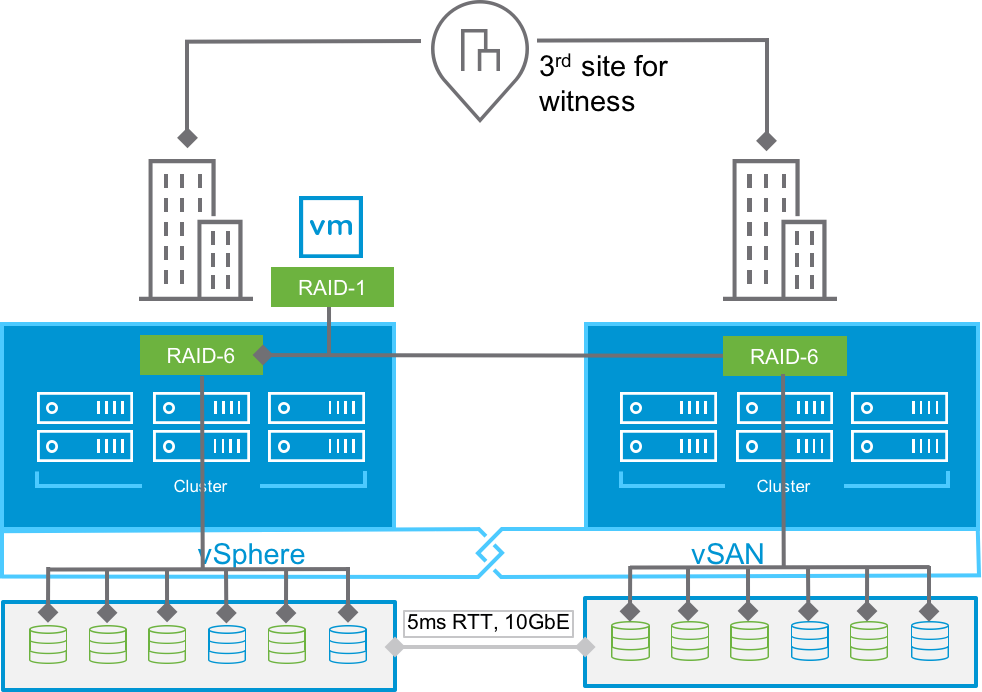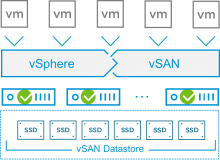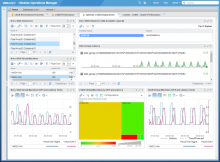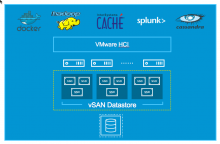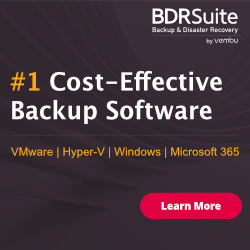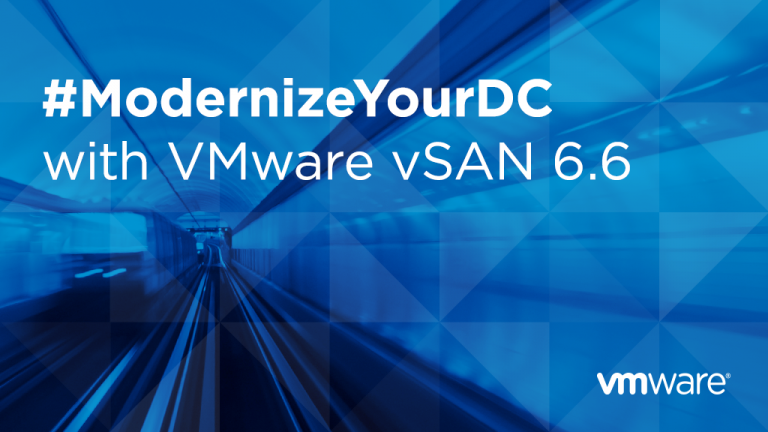
VMware vSAN has been innovating at a rapid pace. With each new release, VMware delivered greater value to our customers through new features that have propelled adoption by mainstream customers for any workload, any application. vSAN is VMware’s industry-leading software powering Hyper-Converged Infrastructure solutions. vSAN 6.6 enhances the industry’s most popular HCI solution with the first native HCI security, highly available stretched clusters, and 50% higher all-flash performance for business-critical and next-generation workloads. More than 7,000 customers trust vSAN to simplify their IT infrastructure and run their business-critical applications to virtual desktops.
VMware HCI takes an integrated approach to let you evolve your data center without risk by accommodating for change in new levels of security and availability requirements, and doing so in a safe, predictable manner. vSAN 6.6 enables you to evolve without risk through native HCI security and more intelligent availability.
Secure Data with vSAN Data-at-Rest Encryption
VMware vSAN 6.6 introduces the industry’s first native HCI security with data-at-rest encryption. Data at rest encryption is built right into vSAN, and is easily enabled to encrypt all objects on a vSAN cluster (the entire vSAN datastore). It is hardware agnostic and doesn’t require the use of specialized Self-Encrypting Drives (SEDs), allowing users the choice to deploy secure HCI on existing storage devices or on the latest storage devices.
Because it runs at the hypervisor level and not in the context of the virtual machine, it is virtual machine agnostic, like VM Encryption. vSAN Encryption is available for both All-Flash and Hybrid configurations and integrates with KMIP 1.1 compliant key management technologies. And vSAN Encryption is fully compatible with vSAN’s all-flash space efficiency features, like inline deduplication and compression, delivering highly efficient and secure storage.
Highly Available Management with the ESXi Host Client
VMware vSAN 6.6 now provides access to the vSAN control plane through the ESXi Host Client, providing an additional management and monitoring option when vCenter Server is offline. This provides greater access to vSAN while accommodating for technical issues or human error that prevents access to vCenter Server.
More Intelligent Rebuilds
VMware vSAN is an extremely intelligent distributed storage system that knows how to balance the data stored across hosts that comprise the vSAN cluster. In vSAN 6.6, rebuilds are more intelligent to better ensure that these self-healing mechanisms have minimal interference with the primary workloads.
vSAN improves on its approach for repairing a protection state to ensure that a VM is adhering to a given protection policy. The improvements in vSAN 6.6 aim to reduce the amount of overhead needed for these repair actions. Some of these include:
- Detect & analyze conditions & determine the best course of action.
- Repair as many degraded or absent components as possible, even if there are not enough resources to ensure full compliance. Remaining components will be repaired as soon as enough resources are available.
- Better balance by splitting large components during redistribution
- Improved visibility in re-balancing status in the Health UI.
- Resync throttling mechanism for Admins to adjust amount of bandwidth available to ensure primary workloads are not impacted
Each of these enhancements helps you evolve without risk. The ability for vSAN to quickly heal itself from hardware failures has been improved significantly in vSAN 6.6.
Degraded Device Handling (DDH)
vSAN 6.6 provides a more proactively stable environment by way of enhancements to the detection of degraded and failing devices. Intelligent, predictive failure handling allows vSAN 6.6 to proactively migrate data to alternate devices by continually analyzing the health of storage devices and identifying devices that exhibit declining health before they completely fail.
This is a proactive process that does not require any interaction from the administrator, provided there is available capacity in the cluster.
Capacity and Policy Pre-Checks
Routine maintenance such as putting a host into maintenance mode or tasks such as decommissioning a host, or disk group, from a cluster have traditionally required pre-planning. Some planning scenarios include things like “How many hosts can be taken offline while still meeting policy compliance?” or “Is there enough room in the cluster to decommission this drive?”
With no additional steps, using today’s existing workflows, vSAN 6.6 now displays the potential effects of these operations on the cluster. This provides a simple and effective way to help administrators make the best choices, while understanding the effects of the maintenance or decommissioning event.
Lower TCO
Software solutions that are smarter help reduce the design and operational burden of a data center. By shifting features away from platform independent hardware, and toward software, organizations will see a significant reduction in both CapEx and OpEx. Let’s look at how vSAN 6.6 can lower TCO with efficient, intelligent operations.
Enhanced Stretched Clusters with Local Failure Protection
vSAN’s ability to provide a fully active-active, stretched cluster has already been proven. vSAN 6.6 takes this a step further, allowing for storage redundancy within a site AND across sites at the same time. With this, we are able to deliver the industry’s best site protection at half the cost of many competing, leading solutions.This helps deliver effective, affordable protection against entire site outages, as well as host outages within a site. When using across sites and within site protection, data does not have to be fetched from the alternate site in the event of a host or disk failure, helping deliver greater performance along with the added layer of protection. This allows for mirrored protection across sites (RAID1), as well as mirrored protection for Hybrid architectures, and either mirrored (RAID1) or erasure coding (RAID5/6) protection for All-Flash architectures within a local site. Each site will still require enough hosts to meet the requirements of the local policy.
Site Affinity for Stretched Clusters
Another addition to vSAN 6.6 Stretched Clusters, is the ability to configure site affinity. This can be beneficial in a few ways. While production workloads may require cross site protection, other workloads such as testing, development, or staging workloads may not. In vSAN 6.6, policies can be applied to keep data in only a single site of the vSAN Stretched Cluster.
This is also beneficial for some workloads that have application level availability or redundancy. In cases where an application provides additional redundancy, protecting it across sites may not be necessary. Applications such as Microsoft Exchange using DAGs or Microsoft SQL Server using AAGs, provide application level redundancy and may not require copies of each virtual machine written to each site. This approach reduces the amount of bandwidth required between sites for these types of workloads.
Cloud-friendly Networking with Unicast
VMware vSAN 6.6 takes a major step in simplifying the design and deployment by removing the need for multicast network traffic. This can provide a noticeably simpler deployment effort for single site environments and vSAN Stretched Clusters. Once a cluster has been upgraded to vSAN 6.6, all hosts will cease to use multicast and use only use unicast. Going forward, vSAN will continue to use unicast for cluster communications.
vSAN Cloud Analytics
vSAN 6.6 introduces pro-active cloud analytics that delivers intelligence to you in order to aid in the health checks of your vSAN environment. By participating in the Customer Experience Improvement Program (CEIP), customers impacted by new support recommendations or best practices will be alerted with new, real-time information and actionable insights. Using pro-active cloud analytics will help enable a smarter way to manage your environment. The cloud-based architecture can be updated in real-time as new recommendations are created and passed to the customer immediately without requiring customer intervention or vSAN updates.
Management at Scale
VMware has always believed strongly in the “APIs first” approach, and with vSAN 6.6, the SDK has been enhanced to provide access to unique data that vSAN can collect. Exposing this data via API helps complementary solutions that use these APIs deliver more value, and drives down TCO. PowerCLI has also proven to be a flexible way to interface with vSAN. vSAN 6.6 introduces new cmdlets that incorporate new functionality introduced in vSAN.
Easier Deployment and Configuration
Deploying vSAN is very easy once some requirements are in place. Some of the basic requirements necessary include vSAN tagged NICs as well as other recommendations like vSphere HA/DRS being configured and vMotion in place. Previously, administrators had to have these pieces configured before using the one-click configuration of vSAN. In some cases, many of these required vCenter Server to be available to perform these tasks. With vSAN Easy Install, deploying the 1st vSAN host is performed as part of the VCSA appliance deployment. There is no longer a requirement to bootstrap a host with a datastore for the VCSA. Easy Install will configure the 1st host and deploy the VCSA on it. That’s just part one. vSAN Configuration Assist takes the baton from the VCSA installer, and guides administrators through the other requirements of vSAN. Once hosts are added, Configuration Assist recommends next steps and provides a central location to perform those steps from. Need a vSAN VMkernel interface on all hosts? Click a simple button to fix and set. Checking for the latest OEM firmware and drivers for the host, as well as ensuring that software configuration settings for vSAN are set optimally, is now simple and part of the guided process.
New enhancements also help with ongoing hardware lifecycle management. vSAN Configuration Assist helps automate the updating of the IO controller’s firmware and driver from many of our hardware partners. With a single button click, vSAN can now download the latest, certified driver and fully orchestrate the installation of that driver across all of the hosts in a cluster. This automated process can greatly reduce management time required to ensure optimal hardware health. Today, this feature is supported on hardware from Dell EMC, Fujitsu, Lenovo and SuperMicro. Easy Install and Configuration Assist strive to make the deployment and maintenance of vSAN easier for the user.
Enhanced Health Monitoring
Effective operation of an environment requires easy, rapid understanding of an issue that needs to be addressed. Enhanced vSAN Health Services in vSAN 6.6 provides better visibility of the health of the environment.
Advanced HCL checks not only include checking for the latest OEM firmware and drivers for select device controllers, but also allow for the download and installation of drivers and firmware, as well as ensuring software configuration settings. Alerting has been tuned to provide more concise information, while reducing the number of duplicate alerts.
vRealize Operations Management Pack for vSAN
Integration is a key benefit of VMware’s implementation of SDDC and vSAN plays a significant part in this path to SDDC. VMware vRealize Operations (vR Ops) is a great example of how this integration can be exploited. Using the vR Ops Management for vSAN, the same level of monitoring and analytics for vSphere is easily extended to vSAN. Let vROps provide the insight needed to make smart design, operation, and optimization decisions.
Scale to Tomorrow
Having a scalable infrastructure that can easily accommodate change is the key to a successful data center. New services require new demands of the data center. The ability to adapt a data center to these next generation services using next generation hardware has historically been very difficult, and expensive. Let’s take a look at how vSAN 6.6 can scale to tomorrow by powering new applications and hardware.
Up to 50% Greater Performance
vSAN’s performance and efficiency is unmatched to any other solution in the industry. In order to accommodate more demanding workloads, a number of optimizations have occurred in vSAN 6.6 to deliver even higher performance. Whether it be data services such as deduplication and compression, or back-end I/O handling by the object managers, vSAN 6.6 improves on performance throughout the stack to deliver better performance, more consistently – with testing results showing up to 50% greater performance for all-flash systems using the data services compared to vSAN 6.5.
Some of these performance enhancements include
- Reduced overhead of checksum
- Improved deduplication and compression
- Destaging optimizations
- Object Management improvements
- iSCSI for vSAN performance improvements
We’ve also previously included more accurate cache sizing guidelines in vSAN 6.5 which continue to be used in vSAN 6.6.
Support for the Latest Hardware Innovations
VMware vSAN has strived to provide robust support for the latest hardware innovations. vSAN 6.6 will continue to accelerate support new hardware adoption with Day 0 support of the latest flash technologies, like the new Intel® Optane NVMe SSDs based on the latest 3D XPoint technology. The broad choice of new hardware platforms and strong ecosystem of vSAN provides the fastest path to next-generation server platforms and flash devices. vSAN 6.6 also provides larger caching drive options, including 1.6TB flash drives, so that customers can take advantage of the latest and larger capacity flash drives.
New Apps
vSAN’s ability to deliver supreme performance and efficiency is one reason behind its ability to deliver next generation applications. We have and will continue to release reference architectures for large applications like Intersystems Caché, Hadoop, and other Big Data solutions, as well as XenDesktop and XenApp in order to provide better guidance of how to get the most out of these solutions. Don’t forget that vSAN is tightly integrated with the ability to run cloud native apps using cluster managers such as Mesos, Kubernetes, and Swarm. And a new vSphere Docker Volume Driver provides enhanced functionality, like multi-tenancy, snapshots and cloning, for Docker users deploying on vSAN. It’s this flexibility that allows organizations to adopt a blend of workload types, whether they be traditional applications, or containers, all running on the same platform.
Summary
With all of these features and enhancements, vSAN 6.6 is by far the biggest release to date! VMware vSAN continues to innovate at a rapid pace, bringing enterprise security, performance, availability, and management to today’s software defined infrastructure.



